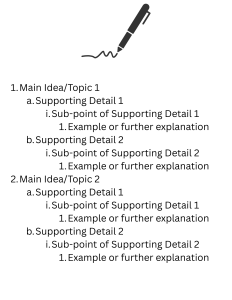2.5 Outlining Textbooks
Rachel Cox-Vineiz, MA and Erin Thomas, MFA
Mastering Textbook Outlining
There are many strategies for helping you understand and retain the information you read. You’ve already learned about annotating and highlighting. Outlining is an active reading strategy, often used with annotating and highlighting, to help you understand, organize, and remember key information. These techniques work together to deepen your engagement with the text and improve retention.
What is Textbook Outlining?
Textbook outlining is a method of organizing the main ideas and supporting details of a chapter or section in a hierarchical format (arranged in order of rank). Think of it like creating a structured roadmap of the text. Instead of just reading words, you’re actively identifying the core concepts and how they relate to each other.
A typical outline uses a combination of Roman numerals, capital letters, Arabic numerals, and lowercase letters to show the levels of importance:

Benefits of Outlining
- Improves Comprehension: Actively engaging with the text to identify key points forces you to understand the material more deeply.
- Enhances Retention: Organizing information in a structured way makes it easier to remember.
- Aids in Review: Outlining provides a concise summary for studying and test preparation.
- Develops Critical Thinking: Learning to distinguish between main ideas and supporting details will build critical thinking skills.
When Should You Outline?
- Complex Chapters: When the material is dense, technical, or introduces many new concepts.
- Preparing for Exams: An outline serves as an excellent study guide, highlighting the most important information.
- Writing Assignments: Understanding the structure of a chapter can help you integrate information into your own writing.
- When Passive Reading Isn’t Working: If you find yourself reading without truly absorbing the information, outlining can help you focus.
You don’t necessarily need to outline every page of every chapter. Consider outlining sections that seem particularly important or challenging. Also, outline those sections of the text emphasized by your instructor.
How to Develop an Effective Outline: A Step-by-Step Guide
- Preview the Chapter: Before diving in, take a moment to look at the chapter title, headings, subheadings, and any introductory or concluding remarks. This gives you a general sense of the chapter’s organization and main topics.
- Read Actively, Section by Section: Don’t try to outline the entire chapter at once. Focus on one section (usually marked by a subheading) at a time. As you read, identify:
- Main Ideas: What is the central point the author is making in this section? This will likely become a Roman numeral in your outline.
- Supporting Details: What information does the author provide to explain, illustrate, or support the main idea? These will become capital letters under the main idea.
- Sub-points and Examples: Are there further explanations, examples, or evidence that support the supporting details? These will be listed with Arabic numerals and lowercase letters.
- Use Your Own Words: Try putting the textbook’s ideas into your own words. This helps you understand the material, even if it has new terms. While you’ll want to keep key terms and facts as they are, rephrasing the surrounding explanations in your familiar language can make the information much easier to grasp and remember. Your notes are for you, so make them make sense to you.
- Be Concise: An outline should be a summary, not a verbatim transcription. Focus on the essential information.
- Maintain Hierarchy: Use the numbering and lettering system consistently to show the relationship between ideas. Main ideas are at the highest level, with supporting details and sub-points indented below them.
- Review and Refine: Once you’ve finished outlining a section or the entire chapter, take a moment to review your outline. Does it accurately reflect the main points of the text? Is the organization logical? Make any necessary adjustments.
Example (Simplified):
Let’s say a section of a psychology textbook is titled “Theories of Learning.” Your outline might start like this:
I. Theories of Learning
A. Behaviorism
1. Classical Conditioning
a. Pavlov’s experiments with dogs
B. Cognitive Psychology
1. Information Processing Model
2. Social Learning Theory
Practice Makes Perfect!
Don’t be discouraged if your first few attempts at outlining feel a bit awkward. Like any skill, outlining improves with practice. Experiment with different levels of detail to find what works best for you and the specific subject matter.
Instructions
- In this exercise, you will outline a selection of a textbook.
- Preferably, you will select a text from one of your subject-matter courses. Try to outline 4-5 pages of text (do as much as you can in 30-45 minutes).
- Alternately, you can use the sample textbook selection, “The Great Depression: 23.11 The Lived Experience of the Great Depression; 23.12 Migration and the Great Depression,” which is located in 2.4 Annotating Textbooks.
- Answer the following questions about the text you have outlined:
- Read your outline. Did you include enough information to remember the key points of the chapter?
- Is it clear and logical? Can you understand the line of reason or argument of the text by reading the outline?
- If you were studying for a test, would it be enough to read your outline or would you have to reread the chapter?
- Is your outline consistent or did it get more irregular as you went?
- In class only: Compare your outline with the outline of a classmate. Explain what you notice:
- Did your classmate include the same ideas?
- Did your classmate include more or less information than you did?
- Ask your classmate about the system that they used to outline. Is it similar or different to yours? Explain.
Media Attributions
- Outlining © Rachel Cox-Vineiz is licensed under a CC BY-NC-SA (Attribution NonCommercial ShareAlike) license

